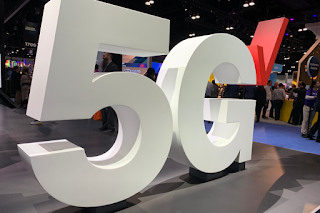John Stankey will take over as CEO of AT&T effective July 1, 2020, replacing the retiring Randall Stephenson (60) who has served in the position for the past 13 years.
Stephenson will continue to serve as Executive Chairman of AT&T until January 2021.
 John Stankey (57) has served as President and Chief Operating Officer of AT&T since October 2019. He joined AT&T in 1985 and has served in a variety of roles, including: CEO of WarnerMedia; CEO of AT&T Entertainment Group; Chief Strategy Officer; Chief Technology Officer; CEO of AT&T Operations; and CEO of AT&T Business Solutions. He holds a bachelor's degree in finance from Loyola Marymount University and an M.B.A. from UCLA.
John Stankey (57) has served as President and Chief Operating Officer of AT&T since October 2019. He joined AT&T in 1985 and has served in a variety of roles, including: CEO of WarnerMedia; CEO of AT&T Entertainment Group; Chief Strategy Officer; Chief Technology Officer; CEO of AT&T Operations; and CEO of AT&T Business Solutions. He holds a bachelor's degree in finance from Loyola Marymount University and an M.B.A. from UCLA.
“I’m honored to be elected the next CEO of AT&T, a company with a rich history and a bright future,” said Stankey. “My thanks go to Randall for his vision and outstanding leadership during a period of tremendous change and investment in the core capabilities needed to position AT&T well for the years ahead. And I appreciate the Board’s confidence in me leading the company during our next chapter of growth and innovation in keeping people connected, informed and entertained. We have a strong company, leading brands and a great employee team, which I’m privileged to lead. I couldn’t be more excited about the new opportunities we have to serve our customers and communities and create value for our shareholders.”
Stephenson said, “I congratulate John, and I look forward to partnering with him as the leadership team moves forward on our strategic initiatives while navigating the difficult economic and health challenges currently facing our country and the world. John has the right experiences and skills, and the unflinching determination every CEO needs to act on his convictions. He has a terrific leadership team onboard to ensure AT&T remains strong and continues to deliver for customers and shareholders for years to come.”
Stephenson will continue to serve as Executive Chairman of AT&T until January 2021.
 John Stankey (57) has served as President and Chief Operating Officer of AT&T since October 2019. He joined AT&T in 1985 and has served in a variety of roles, including: CEO of WarnerMedia; CEO of AT&T Entertainment Group; Chief Strategy Officer; Chief Technology Officer; CEO of AT&T Operations; and CEO of AT&T Business Solutions. He holds a bachelor's degree in finance from Loyola Marymount University and an M.B.A. from UCLA.
John Stankey (57) has served as President and Chief Operating Officer of AT&T since October 2019. He joined AT&T in 1985 and has served in a variety of roles, including: CEO of WarnerMedia; CEO of AT&T Entertainment Group; Chief Strategy Officer; Chief Technology Officer; CEO of AT&T Operations; and CEO of AT&T Business Solutions. He holds a bachelor's degree in finance from Loyola Marymount University and an M.B.A. from UCLA.“I’m honored to be elected the next CEO of AT&T, a company with a rich history and a bright future,” said Stankey. “My thanks go to Randall for his vision and outstanding leadership during a period of tremendous change and investment in the core capabilities needed to position AT&T well for the years ahead. And I appreciate the Board’s confidence in me leading the company during our next chapter of growth and innovation in keeping people connected, informed and entertained. We have a strong company, leading brands and a great employee team, which I’m privileged to lead. I couldn’t be more excited about the new opportunities we have to serve our customers and communities and create value for our shareholders.”
Stephenson said, “I congratulate John, and I look forward to partnering with him as the leadership team moves forward on our strategic initiatives while navigating the difficult economic and health challenges currently facing our country and the world. John has the right experiences and skills, and the unflinching determination every CEO needs to act on his convictions. He has a terrific leadership team onboard to ensure AT&T remains strong and continues to deliver for customers and shareholders for years to come.”
AT&T’s John Donovan steps down
John Donovan, CEO of AT&T Communications, will retire effective October 1. Donovan joined AT&T in 2008 as Chief Technology Officer, overseeing the company’s global technology direction and innovation road map. He was then promoted to AT&T’s Chief Strategy Officer and Group President—AT&T Technology and Operations, before being named CEO of AT&T Communications in July 2017.

“It’s been my honor to lead AT&T Communications during a period of unprecedented innovation and investment in new technology that is revolutionizing how people connect with their worlds,” said John Donovan. “All that we’ve accomplished is a credit to the talented women and men of AT&T, and their passion for serving our customers. I’m looking forward to the future – spending more time with my family and watching with pride as the AT&T team continues to set the pace for the industry.”

“It’s been my honor to lead AT&T Communications during a period of unprecedented innovation and investment in new technology that is revolutionizing how people connect with their worlds,” said John Donovan. “All that we’ve accomplished is a credit to the talented women and men of AT&T, and their passion for serving our customers. I’m looking forward to the future – spending more time with my family and watching with pride as the AT&T team continues to set the pace for the industry.”


















